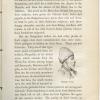Drawing of a Bulgarian man
Commentary
Drawing in pencil by Arthur Evans of a man’s head and shoulders, captioned ‘Bulgarian profile’, identified as a portrait of a Bulgarian man sketched in Maksimir Park on the outskirts of Zagreb, Croatia.
Artist: Arthur John Evans
Date of drawing: August 1875
Continent: Europe
Geographical area: Southern Europe
Country: Croatia
Region/Place: Zagreb
Cultural group: European Bulgarian
Format: Drawing
Size: 60 x 44 mm; 125 x 81 mm (with mount)
Acquisition: Joan Evans. Donated August 1941
***
Primary documentation: ‘[p.588] Dr. JOAN EVANS, from the property of the late SIR ARTHUR EVANS, Youlbury, Boars Hill, Oxford. [List of items follows]’; ‘[p.590] 21 Original pencil sketches, types & scenery. BALKANS’: Pitt Rivers Museum accession records (Donations X, 1937–1941), pp.588, 590. Annotations on drawing: ‘Bulgarian profile’ (written in pencil below drawing).
Research notes: It has been identified by Philip Grover that this original drawing was used as the artwork for a woodcut engraving subsequently published in Arthur J. Evans, Through Bosnia and the Herzegóvina on Foot during the Insurrection, August and September 1875 (London, 1876), p.31, printed with the caption ‘Bulgarian Profile’. Evans recorded in the volume: ‘I had noticed in the market, sitting apart from the light Croat country people, a man selling vegetables of a different kind to the others, with vestments of a duller hue, and on his head a black conical sheepskin cap, which recalled to mind the head-gear of the Bulgarians of the Lower Danube, and sure enough a Bulgarian he turned out to be. On enquiring I found that a small Bulgarian colony had settled near the Archbishop’s Park of Maximir, to tracking out which I devoted my last afternoon at Agram. [...] The colony consisted of two very rude straw-thatched sheds, which seemed all thatch and no wall, insomuch that on approaching them I at first mistook them for two long, irregular haystacks. One of the hovels was for dwelling-house and the other as a shelter for vegetable stores, filled with gherkins and onions, and overgrown by a vine-leaved pumpkin. The dwelling-house had a kind of porch or atrium; that is to say, the thatched eaves, supported by two poles, projected almost as far in front of the door as the one room extended behind it. Under this canopy were seated two Bulgarians, hard at work tying up bundles of onions, clad in their dark national costume - the brown tight-sleeved jacket embroidered with black, the dull red sash, the brown trowser-leggings which are equally Turkish and Tartar, and on their head the black sheepskin cap which had at first attracted my attention; while on a peg behind hung one of their heavy mantles of the same black, shaggy sheepskin. [...] But the Bulgarians before me had other proofs of their origin even more unmistakable than their attire. Their pedigree is written on their faces. These are not Sclavonic. They are of that type, more easily recognised than described, Mongolian in its widest sense, which extends from the White Sea shores, among Lapps and Samoyeds, Beormas and Voguls, to the Tartars and Chinese. Here are the curiously prominent cheek-bones, the broad and otherwise flat face, the small sunken eyes, the nose flat at top and inclined to be globular below; their eyebrows are strong and relieved; their complexion is dark, their head shaven save one black tuft or tail; they are true Ugrians, the ogres of our nursery stories. The purity of their breed, as evinced by this strangely Asiatic physiognomy, was partly explained by the locality of their home. They had come, so they said, from Ternova, the holy city of the Bulgarians, the destination of their pilgrimages, the seat of their old metropolitans. This was the last stronghold of the national dynasty, and to the last the original Ugrian nucleus of the race may have clustered round it - who knows? even these poor peasants may have been descendants of Bulgarian kings!/ They had come all the way up the Danube and Save to scrape together money by their superior agricultural industry among the lazier Croats, and having brought with them some of their native seeds, were able to expose for sale gherkins of peculiar forms, and finer kinds of onions, in the Agram market. While I was there two more of the party came up; and one of them, a fine young fellow dressed in European costume, I did not suspect to be a Bulgarian till he told me in German that he belonged to the settlement, and had come with them for a still more laudable purpose, namely, to obtain a good education. They had been here now three years, and having scraped together some earnings, purposed to return this autumn. The savingness of the race was noticeable in their clothing, which was the same they had brought with them from Bulgaria; but I do not think that any amount of patching and mending could make it hold together much longer. The good-humour which also distinguishes their race beamed forth from their every feature; they were evidently very pleased to see a visitor, were delighted to let me sketch them, and one sat quietly while I took his profile. They invited me to visit the inside of their hut, whose thatch was partly eked out with vine leaves and fir branches’: Through Bosnia and the Herzegóvina on Foot, pp.27, 28–29, 31, 32. Note that Agram is the German name for Zagreb, Croatia.

